TOYOTA COROLLA CROSS HYBRID 2023 Owners Manual
Manufacturer: TOYOTA, Model Year: 2023, Model line: COROLLA CROSS HYBRID, Model: TOYOTA COROLLA CROSS HYBRID 2023Pages: 516, PDF Size: 15.96 MB
Page 421 of 516
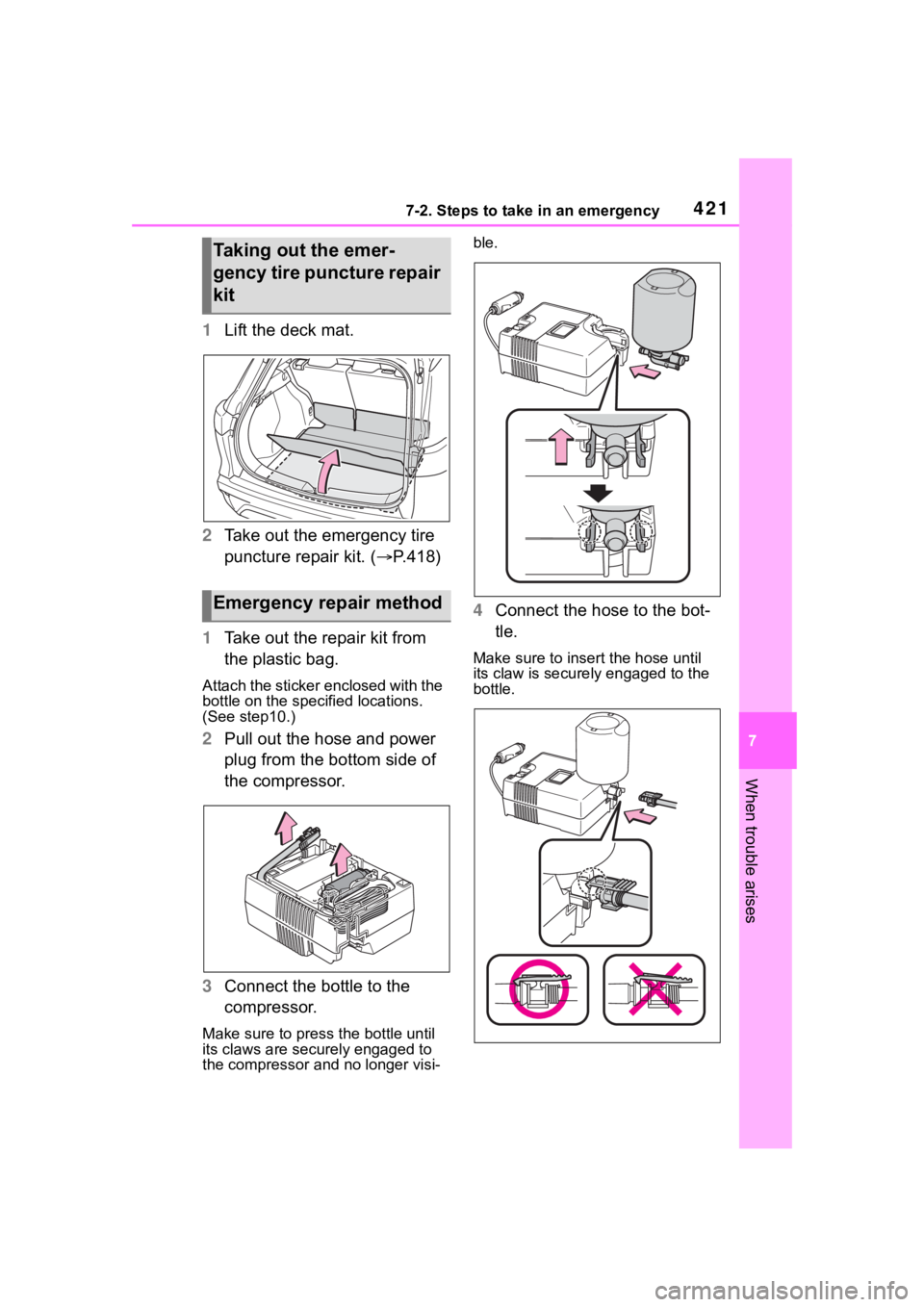
4217-2. Steps to take in an emergency
7
When trouble arises
1Lift the deck mat.
2 Take out the emergency tire
puncture repair kit. ( P.418)
1 Take out the repair kit from
the plastic bag.
Attach the sticker enclosed with the
bottle on the specified locations.
(See step10.)
2Pull out the hose and power
plug from the bottom side of
the compressor.
3 Connect the bottle to the
compressor.
Make sure to press the bottle until
its claws are securely engaged to
the compressor and no longer visi- ble.
4
Connect the hose to the bot-
tle.
Make sure to insert the hose until
its claw is securely engaged to the
bottle.
Taking out the emer-
gency tire puncture repair
kit
Emergency repair method
Page 422 of 516
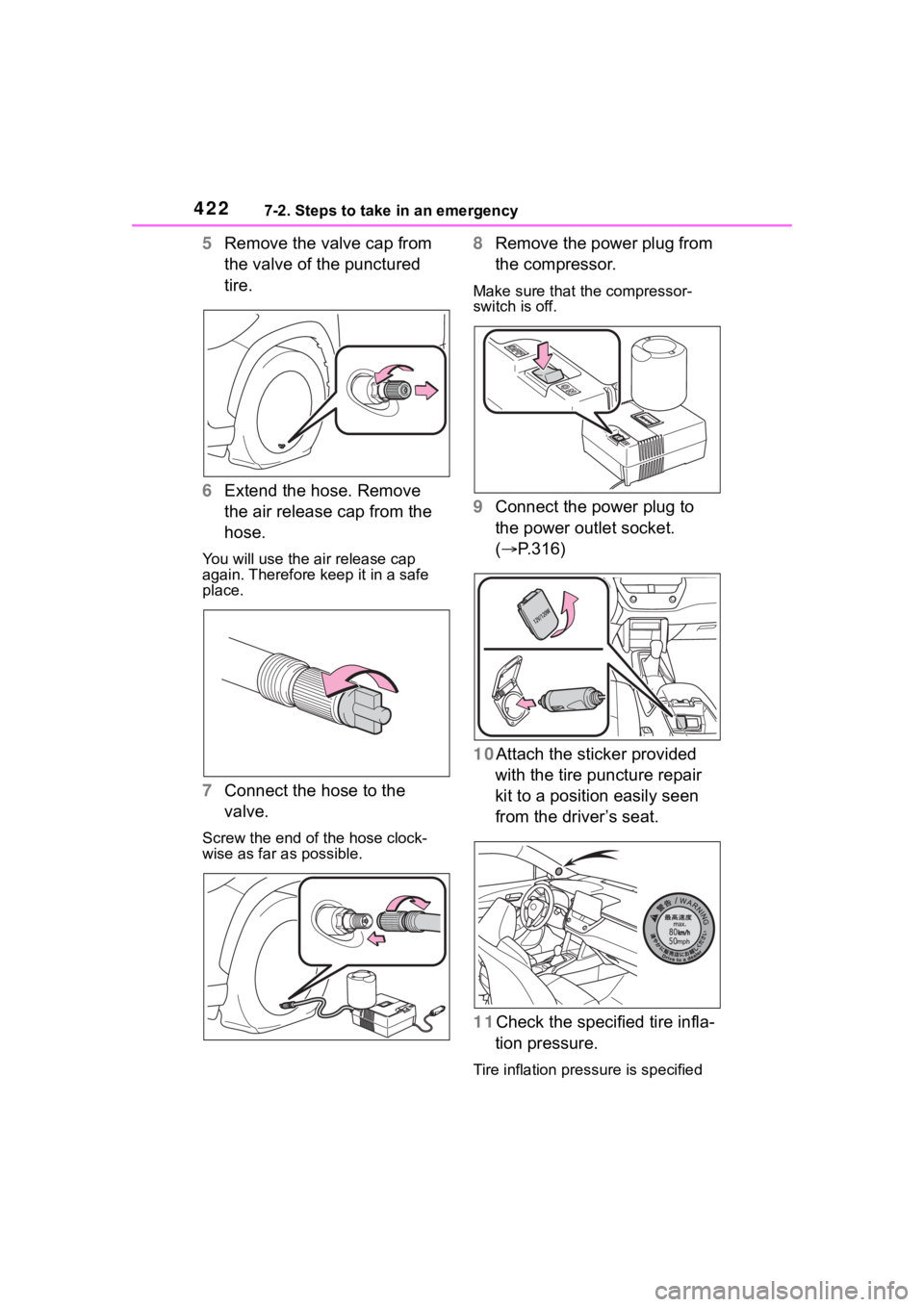
4227-2. Steps to take in an emergency
5Remove the valve cap from
the valve of the punctured
tire.
6 Extend the hose. Remove
the air release cap from the
hose.
You will use the air release cap
again. Therefore keep it in a safe
place.
7Connect the hose to the
valve.
Screw the end of the hose clock-
wise as far as possible.
8Remove the power plug from
the compressor.
Make sure that the compressor-
switch is off.
9Connect the power plug to
the power outlet socket.
( P.316)
10Attach the sticker provided with the tire puncture repair
kit to a position easily seen
from the driver’s seat.
11Check the specified tire infla- tion pressure.
Tire inflation pressure is specified
Page 423 of 516
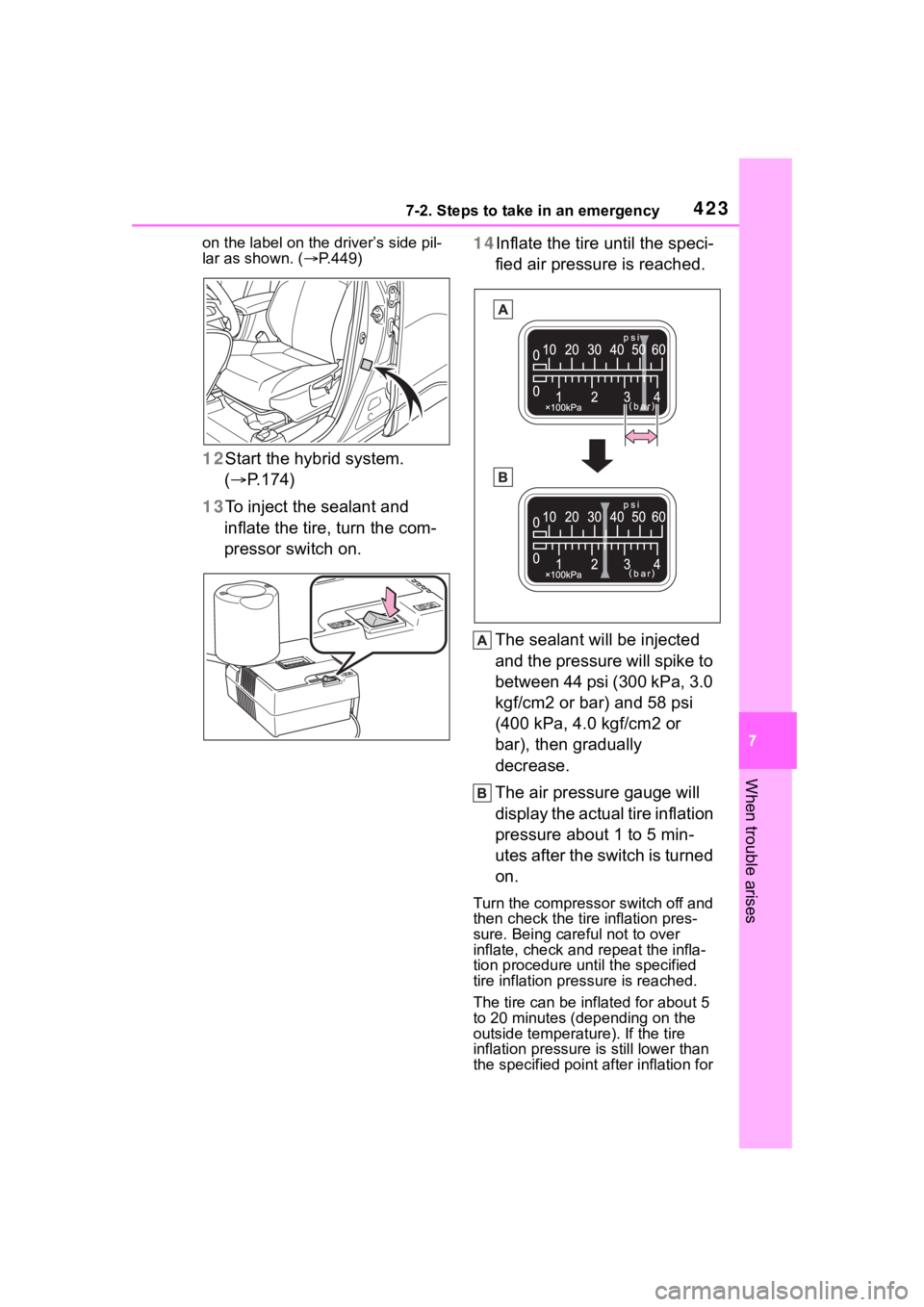
4237-2. Steps to take in an emergency
7
When trouble arises
on the label on the driver’s side pil-
lar as shown. (P.449)
12 Start the hybrid system.
( P.174)
13 To inject the sealant and
inflate the tire, turn the com-
pressor switch on. 14Inflate the tire until the speci-
fied air pressure is reached.
The sealant will be injected
and the pressure will spike to
between 44 psi (300 kPa, 3.0
kgf/cm2 or bar) and 58 psi
(400 kPa, 4.0 kgf/cm2 or
bar), then gradually
decrease.
The air pressure gauge will
display the actual tire inflation
pressure about 1 to 5 min-
utes after the switch is turned
on.
Turn the compressor switch off and
then check the tire inflation pres-
sure. Being care ful not to over
inflate, check and repeat the infla-
tion procedure until the specified
tire inflation pressure is reached.
The tire can be inflated for about 5
to 20 minutes (depending on the
outside temperature). If the tire
inflation pressure is still lower than
the specified point after inflation for
Page 424 of 516
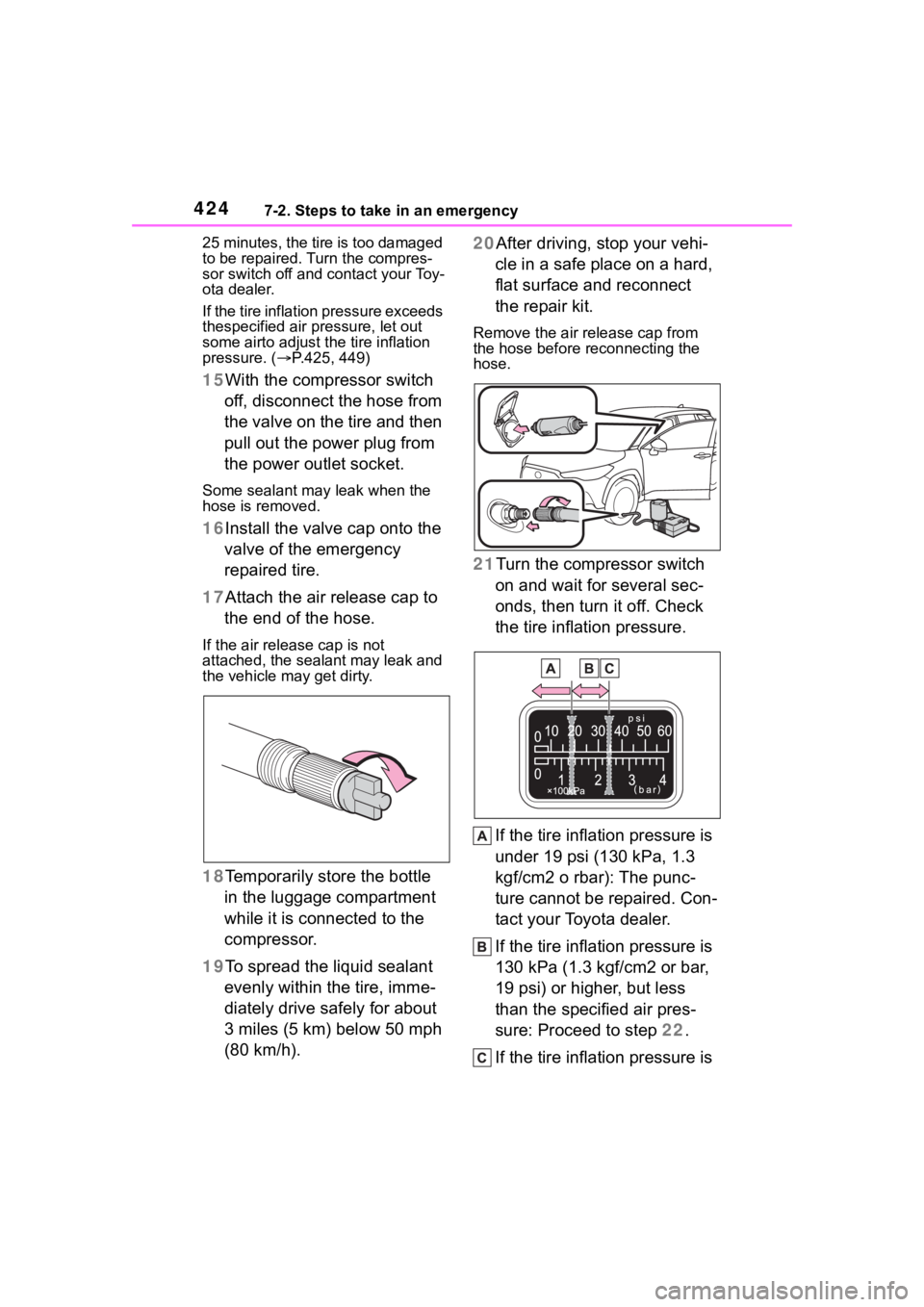
4247-2. Steps to take in an emergency
25 minutes, the tire is too damaged
to be repaired. Turn the compres-
sor switch off and contact your Toy-
ota dealer.
If the tire inflation pressure exceeds
thespecified air pressure, let out
some airto adjust the tire inflation
pressure. (P.425, 449)
15 With the compressor switch
off, disconnect the hose from
the valve on the tire and then
pull out the power plug from
the power outlet socket.
Some sealant may leak when the
hose is removed.
16 Install the valve cap onto the
valve of the emergency
repaired tire.
17 Attach the air release cap to
the end of the hose.
If the air release cap is not
attached, the sealant may leak and
the vehicle ma y get dirty.
18Temporarily store the bottle
in the luggage compartment
while it is connected to the
compressor.
19 To spread the liquid sealant
evenly within the tire, imme-
diately drive safely for about
3 miles (5 km) below 50 mph
(80 km/h). 20After driving, stop your vehi-
cle in a safe place on a hard,
flat surface and reconnect
the repair kit.
Remove the air release cap from
the hose before reconnecting the
hose.
21Turn the compressor switch
on and wait for several sec-
onds, then turn it off. Check
the tire inflation pressure.
If the tire inflation pressure is
under 19 psi (130 kPa, 1.3
kgf/cm2 o rbar): The punc-
ture cannot be repaired. Con-
tact your Toyota dealer.
If the tire inflation pressure is
130 kPa (1.3 kgf/cm2 or bar,
19 psi) or higher, but less
than the specified air pres-
sure: Proceed to step 22.
If the tire inflation pressure is
Page 425 of 516
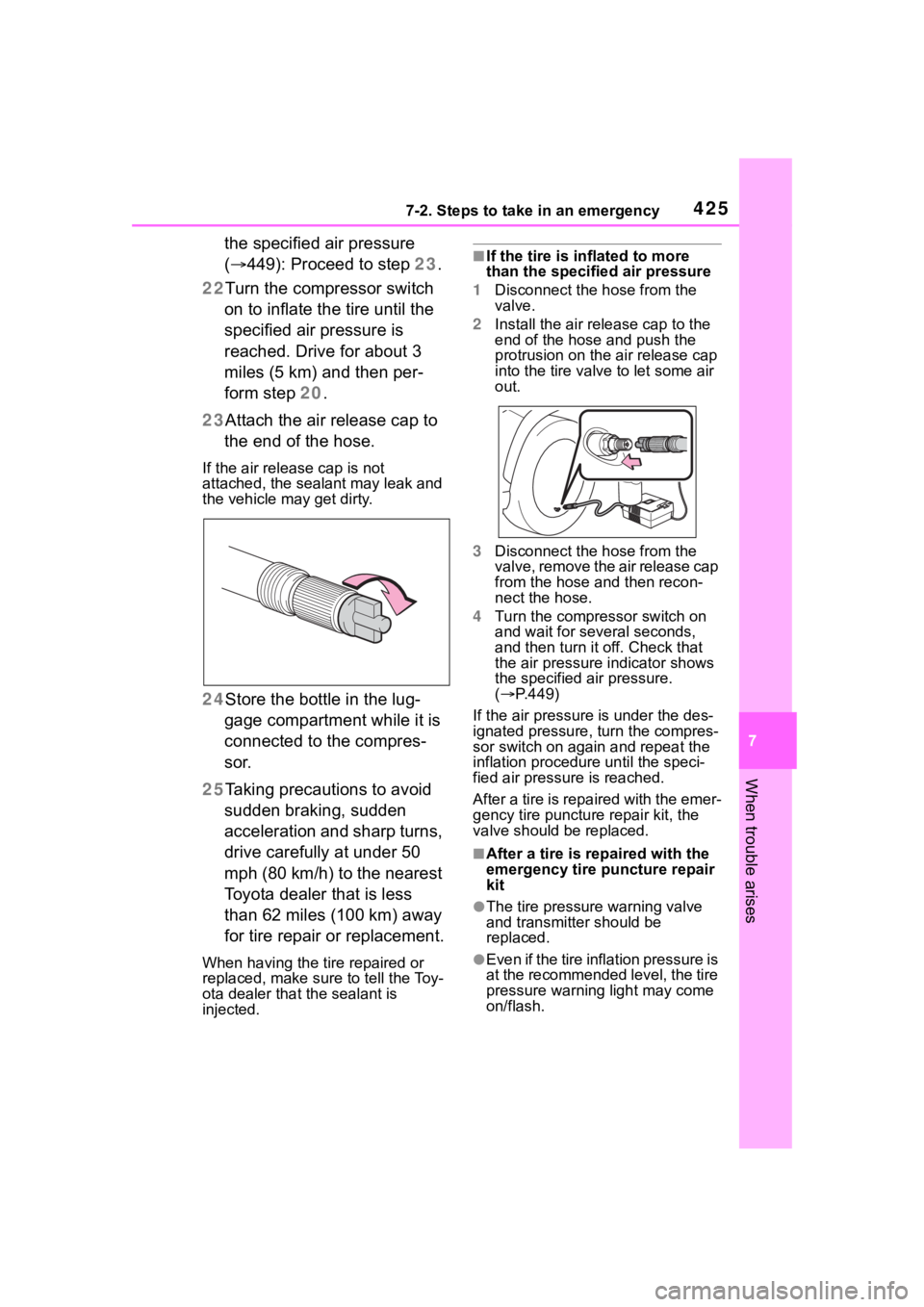
4257-2. Steps to take in an emergency
7
When trouble arises
the specified air pressure
(449): Proceed to step 23.
22 Turn the compressor switch
on to inflate the tire until the
specified air pressure is
reached. Drive for about 3
miles (5 km) and then per-
form step 20.
23 Attach the air release cap to
the end of the hose.
If the air release cap is not
attached, the sealant may leak and
the vehicle ma y get dirty.
24Store the bottle in the lug-
gage compartment while it is
connected to the compres-
sor.
25 Taking precautions to avoid
sudden braking, sudden
acceleration and sharp turns,
drive carefully at under 50
mph (80 km/h) to the nearest
Toyota dealer that is less
than 62 miles (100 km) away
for tire repair or replacement.
When having the tire repaired or
replaced, make sure to tell the Toy-
ota dealer that the sealant is
injected.
■If the tire is in flated to more
than the specifi ed air pressure
1 Disconnect the hose from the
valve.
2 Install the air release cap to the
end of the hose and push the
protrusion on the air release cap
into the tire valve to let some air
out.
3 Disconnect the hose from the
valve, remove the air release cap
from the hose an d then recon-
nect the hose.
4 Turn the compressor switch on
and wait for seve ral seconds,
and then turn it off. Check that
the air pressure indicator shows
the specified air pressure.
( P.449)
If the air pressure is under the des-
ignated pressure, turn the compres-
sor switch on again and repeat the
inflation procedure until the speci-
fied air pressure is reached.
After a tire is repaired with the emer-
gency tire puncture repair kit, the
valve should be replaced.
■After a tire is re paired with the
emergency tire puncture repair
kit
●The tire pressure warning valve
and transmitter should be
replaced.
●Even if the tire inflation pressure is
at the recommended level, the tire
pressure warning light may come
on/flash.
Page 426 of 516
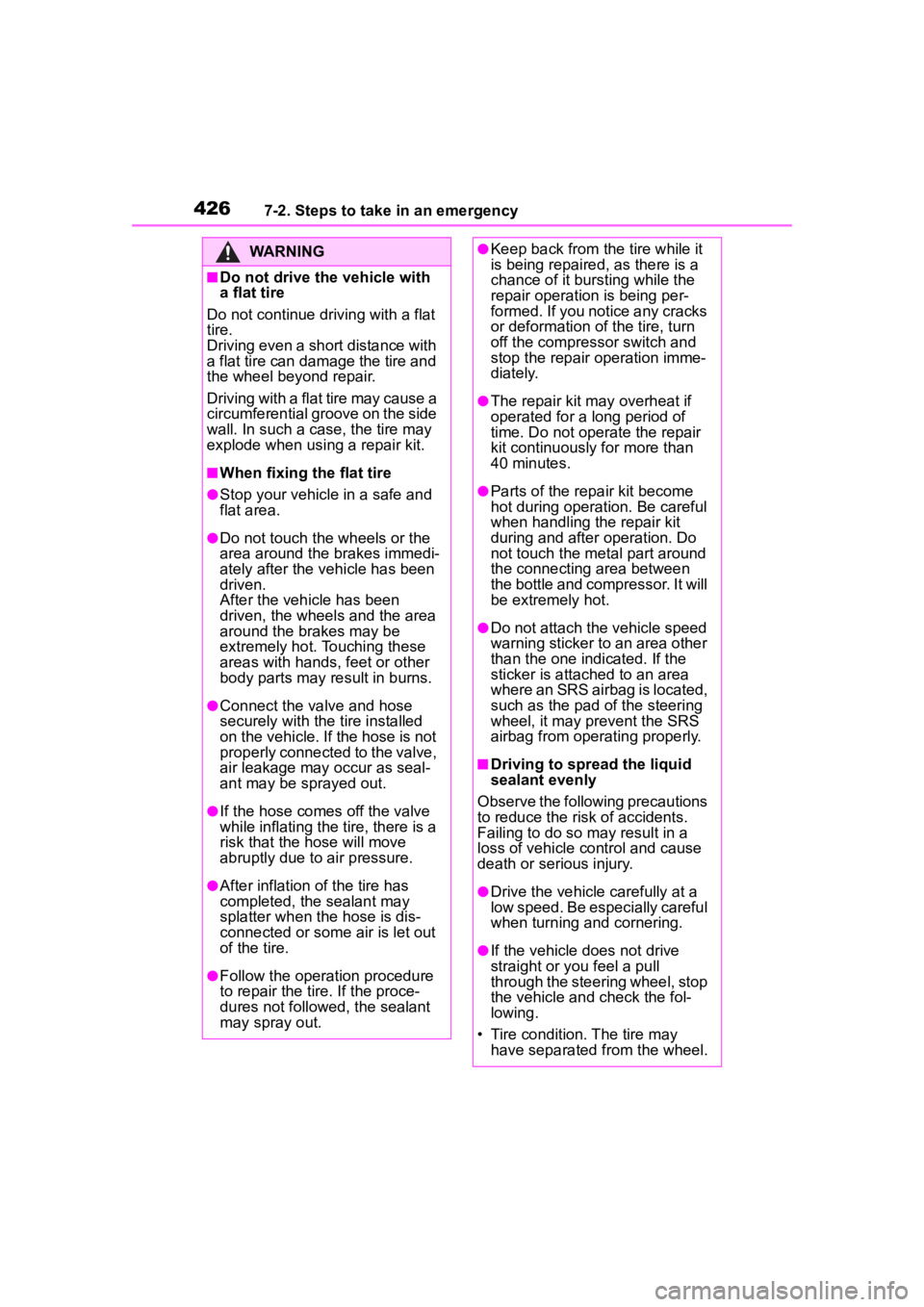
4267-2. Steps to take in an emergency
WARNING
■Do not drive the vehicle with
a flat tire
Do not continue driving with a flat
tire.
Driving even a short distance with
a flat tire can damage the tire and
the wheel beyond repair.
Driving with a flat tire may cause a
circumferential groove on the side
wall. In such a case, the tire may
explode when using a repair kit.
■When fixing the flat tire
●Stop your vehicle in a safe and
flat area.
●Do not touch the wheels or the
area around the brakes immedi-
ately after the vehicle has been
driven.
After the vehicle has been
driven, the wheels and the area
around the brakes may be
extremely hot. Touching these
areas with hands , feet or other
body parts may result in burns.
●Connect the valve and hose
securely with the tire installed
on the vehicle. If the hose is not
properly connected to the valve,
air leakage may occur as seal-
ant may be sprayed out.
●If the hose comes off the valve
while inflating the tire, there is a
risk that the hose will move
abruptly due to air pressure.
●After inflation of the tire has
completed, the sealant may
splatter when the hose is dis-
connected or some air is let out
of the tire.
●Follow the operation procedure
to repair the tire. If the proce-
dures not followed, the sealant
may spray out.
●Keep back from the tire while it
is being repaired, as there is a
chance of it bursting while the
repair operation is being per-
formed. If you notice any cracks
or deformation of the tire, turn
off the compressor switch and
stop the repair operation imme-
diately.
●The repair kit may overheat if
operated for a long period of
time. Do not operate the repair
kit continuously for more than
40 minutes.
●Parts of the re pair kit become
hot during operation. Be careful
when handling the repair kit
during and after operation. Do
not touch the metal part around
the connecting area between
the bottle and compressor. It will
be extremely hot.
●Do not attach the vehicle speed
warning sticker to an area other
than the one indicated. If the
sticker is attached to an area
where an SRS airbag is located,
such as the pad of the steering
wheel, it may prevent the SRS
airbag from operating properly.
■Driving to spread the liquid
sealant evenly
Observe the following precautions
to reduce the risk of accidents.
Failing to do so may result in a
loss of vehicle control and cause
death or serious injury.
●Drive the vehicle carefully at a
low speed. Be especially careful
when turning and cornering.
●If the vehicle does not drive
straight or you feel a pull
through the steering wheel, stop
the vehicle and check the fol-
lowing.
• Tire condition. The tire may have separated from the wheel.
Page 427 of 516
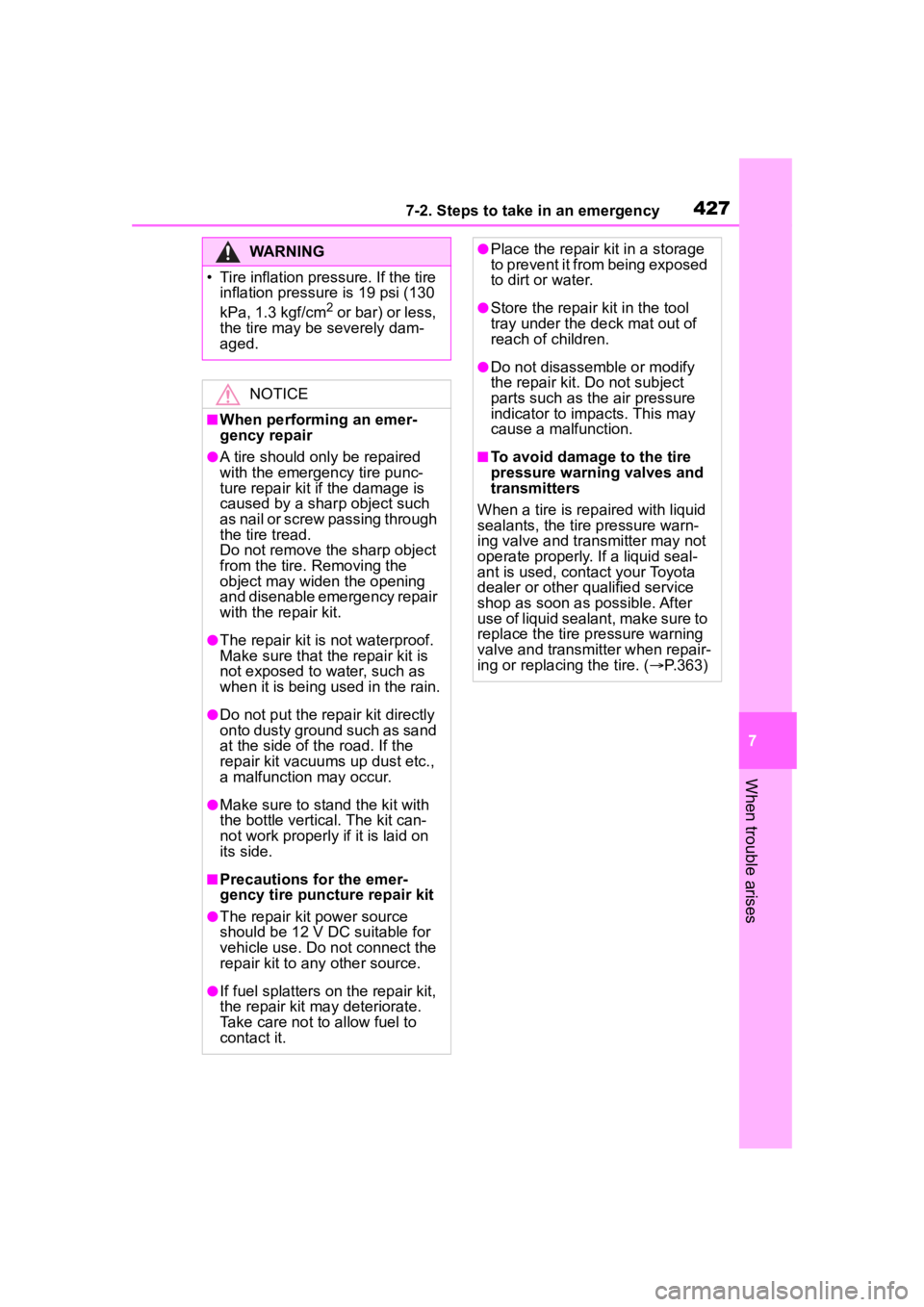
4277-2. Steps to take in an emergency
7
When trouble arises
WARNING
�
Page 428 of 516
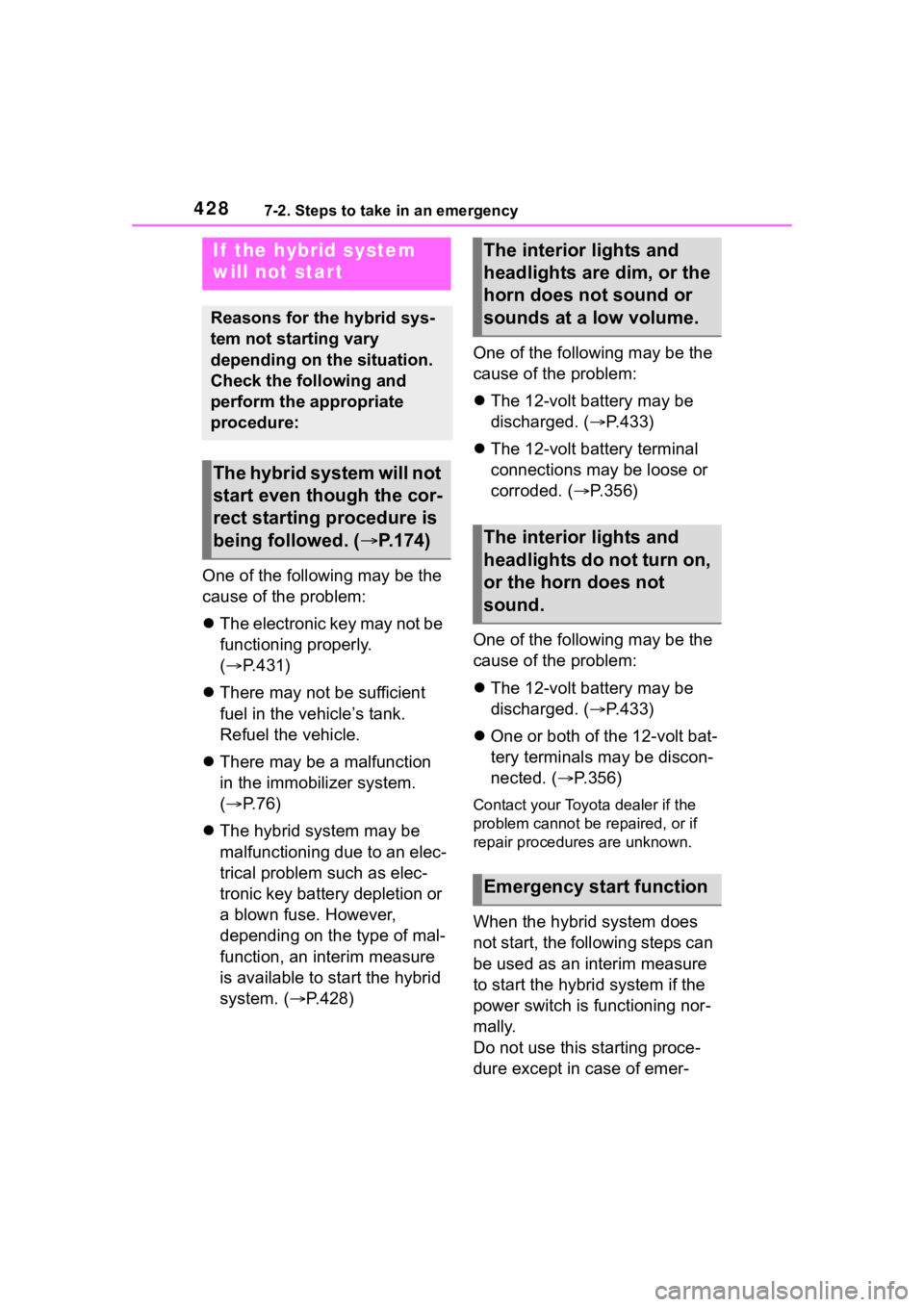
4287-2. Steps to take in an emergency
One of the following may be the
cause of the problem:
The electronic key may not be
functioning properly.
( P.431)
There may not be sufficient
fuel in the vehicle’s tank.
Refuel the vehicle.
There may be a malfunction
in the immobilizer system.
( P. 7 6 )
The hybrid system may be
malfunctioning due to an elec-
trical problem such as elec-
tronic key battery depletion or
a blown fuse. However,
depending on the type of mal-
function, an interim measure
is available to start the hybrid
system. ( P.428) One of the following may be the
cause of the problem:
The 12-volt battery may be
discharged. ( P.433)
The 12-volt battery terminal
connections may be loose or
corroded. ( P.356)
One of the following may be the
cause of the problem:
The 12-volt battery may be
discharged. ( P.433)
One or both of the 12-volt bat-
tery terminals may be discon-
nected. ( P.356)
Contact your Toyota dealer if the
problem cannot be repaired, or if
repair procedures are unknown.
When the hybrid system does
not start, the following steps can
be used as an interim measure
to start the hybrid system if the
power switch is functioning nor-
mally.
Do not use this starting proce-
dure except in case of emer-
If the hybrid system
will not start
Reasons for the hybrid sys-
tem not starting vary
depending on the situation.
Check the following and
perform the appropriate
procedure:
The hybrid system will not
start even though the cor-
rect starting procedure is
being followed. ( P.174)
The interior lights and
headlights are dim, or the
horn does not sound or
sounds at a low volume.
The interior lights and
headlights do not turn on,
or the horn does not
sound.
Emergency start function
Page 429 of 516
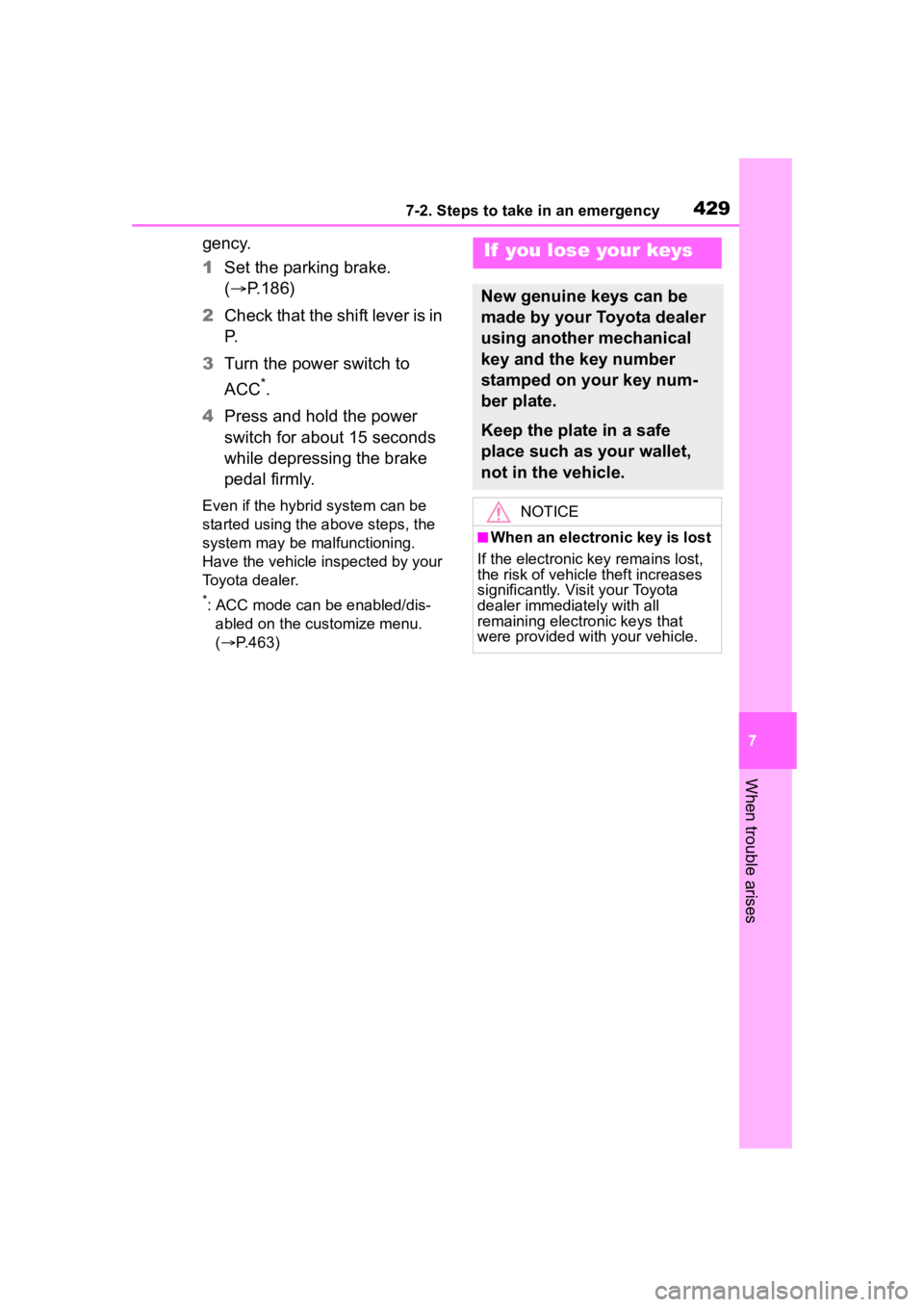
4297-2. Steps to take in an emergency
7
When trouble arises
gency.
1Set the parking brake.
( P.186)
2 Check that the shift lever is in
P.
3 Turn the power switch to
ACC
*.
4 Press and hold the power
switch for about 15 seconds
while depressing the brake
pedal firmly.
Even if the hybrid system can be
started using the above steps, the
system may be malfunctioning.
Have the vehicle inspected by your
Toyota dealer.
*: ACC mode can be enabled/dis-
abled on the customize menu.
( P.463)
If you lose your keys
New genuine keys can be
made by your Toyota dealer
using another mechanical
key and the key number
stamped on your key num-
ber plate.
Keep the plate in a safe
place such as your wallet,
not in the vehicle.
NOTICE
■When an electronic key is lost
If the electronic key remains lost,
the risk of vehicle theft increases
significantly. Visit your Toyota
dealer immediately with all
remaining electronic keys that
were provided with your vehicle.
Page 430 of 516
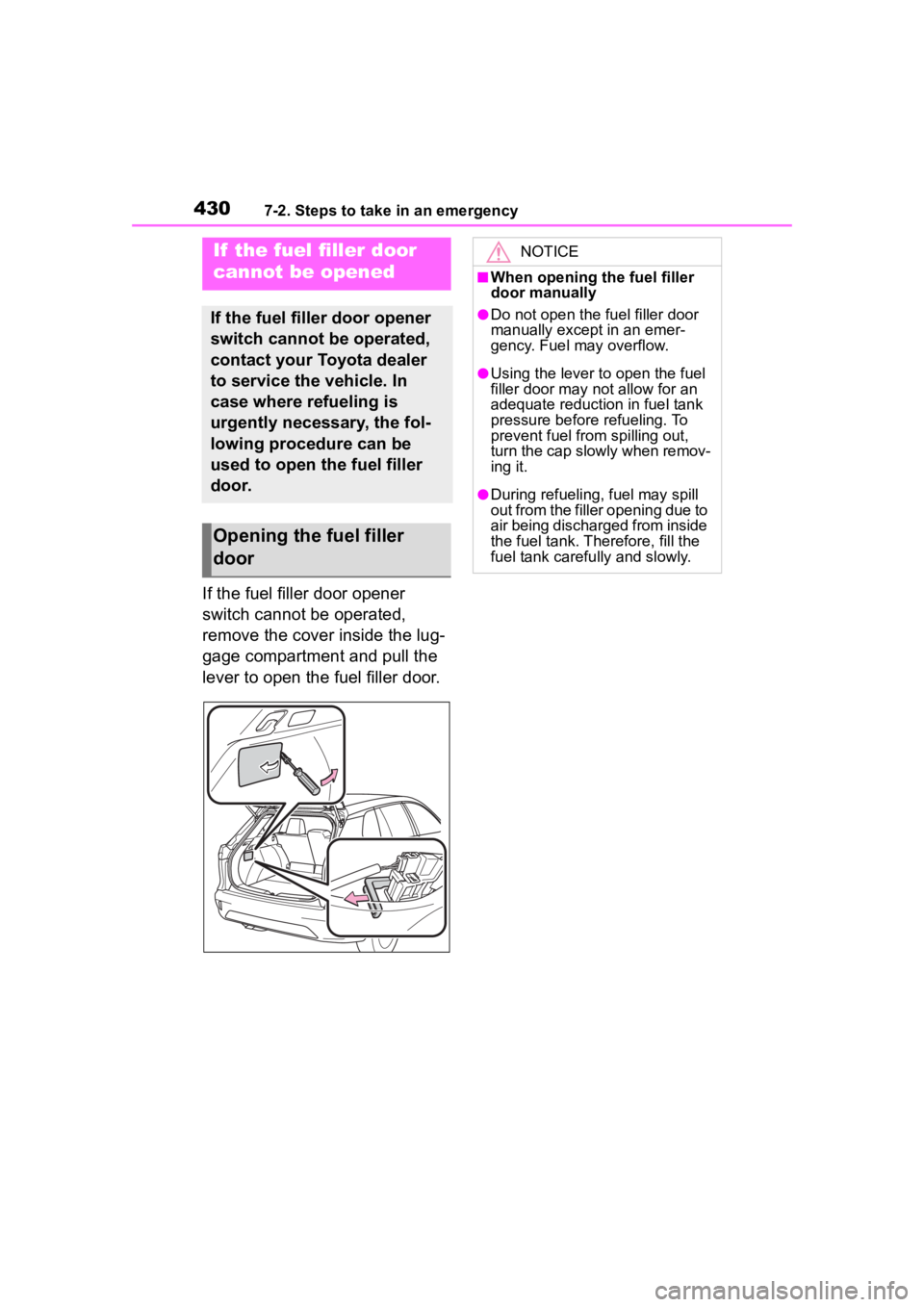
4307-2. Steps to take in an emergency
If the fuel filler door opener
switch cannot be operated,
remove the cover inside the lug-
gage compartment and pull the
lever to open the fuel filler door.
If the fuel filler door
cannot be opened
If the fuel filler door opener
switch cannot be operated,
contact your Toyota dealer
to service the vehicle. In
case where refueling is
urgently necessary, the fol-
lowing procedure can be
used to open the fuel filler
door.
Opening the fuel filler
door
NOTICE
■When opening the fuel filler
door manually
●Do not open the fuel filler door
manually except in an emer-
gency. Fuel may overflow.
●Using the lever to open the fuel
filler door may not allow for an
adequate reduction in fuel tank
pressure before refueling. To
prevent fuel from spilling out,
turn the cap slowly when remov-
ing it.
●During refueling, fuel may spill
out from the filler opening due to
air being discharged from inside
the fuel tank. Therefore, fill the
fuel tank carefully and slowly.